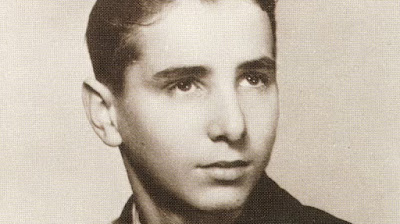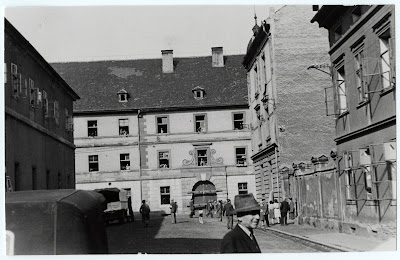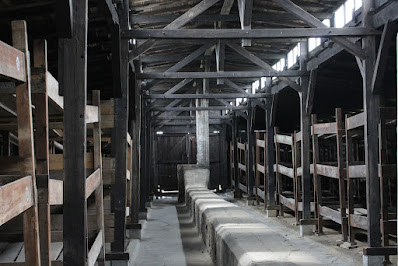Werner Reich: Learning magic in Auschwitz (Part 1)
This two-part blog is published on the first anniversary of Werner Reich’s death (8 Jul 22). An amateur magician, he discovered magic during a chance encounter with a professional magician in the Auschwitz concentration camp. In this remarkable story, we learn how Reich survived the Holocaust and developed a lifelong interest in magic...
Early years and arrest
Werner Reich was a German Jew. Born on 1 October 1927, he grew up in a suburb of Berlin. In 1933, when Werner was six-years-old, Adolf Hitler came to power. Regulations restricting Jewish freedoms followed, including the infamous Nuremberg Laws.
Persecution led to Werner’s father losing his job, so the family emigrated to the Kingdom of Yugoslavia in southeast Europe. The family settled in Zagreb and Werner spent his early school years there, free from anti-Semitism.
As World War Two took hold from 1939, the Reich family was relatively safe in Yugoslavia. But in March 1941, the country’s King regent made an agreement with Germany to join the Tripartite Pact. This led to a coup by Serbian nationalists, under the banner of the young king, Peter II. On 6 April, Germany, Italy and Hungary invaded Yugoslavia from all sides. The country soon capitulated, although partisans continued to vie for control throughout the war.
The Nazi’s soon extended their persecution of the Jews to Yugoslavia. To protect her children, Werner’s mother arranged for German couples to care for him and his sister. His father had died in May 1940.
For a year-and-a-half, Werner mostly stayed inside the home of the couple his mother placed him with, hiding from Nazi officials.
He was arrested, aged just 15-years-old, during an early morning raid on 5 May 1943. After interrogation locally, the Nazis took Reich to Slovenia and then onto Graz in Austria, where they held him at a police station. At the end of June, he was moved to a larger holding centre in Vienna. There the centre’s staff gave him the prisoner number IV 14i857.
Theresienstadt Ghetto
Soon after arriving in Vienna, where Reich was held with a large group of Jews and other untermensch [Nazi term: sub-humans, such as Romani people and homosexuals], the Nazis moved him by train to Theresienstadt in Czechoslovakia.
In November 1941, Reinhard Heydrich, the German chief of the Reich Security Main Office and acting governor of the Protectorate of Bohemia and Moravia, ordered the creation of a ghetto in Theresienstadt [Czech: Terezín], a former garrison town north of Prague. Housing approximately 40,000 people at a time (but peaking at almost 60,000), the ghetto served as a way-station for the shipment of Jews to extermination, concentration and labour camps outside of Czechoslovakia.
A street in Theresienstadt Ghetto during WW2
(Source ICRC)
Used as propaganda by the Nazis (see
‘
The Fuhrer gives the Jews a town’ film), the ghetto was known for its relatively rich cultural life, despite its overcrowding and depravation. Activities (which were ramped up during infrequent Red Cross inspections) included concerts, lectures, and education for children. Nazi propaganda film
‘
The Fuhrer gives the Jews a town’ about Theresienstadt (Source: Periscope Film II, public domain)
In reality, the conditions in Theresienstadt were appalling. Thousands of Jewish men, women and children were concentrated together and the poor conditions hastened the death of its prisoners from malnutrition and disease.
As he was over 15, the Nazi officials forced Reich to work while the younger kids went to school or played:
“The first job I had was making baskets... The next job was laying railroad tracks... Next I was transferred to a broom factory... Then I was transferred to control the lights for the resident opera company... After twenty-five performance, I was assigned to a group of furniture movers... My final job was working with the [vermin] extermination team.”
Unlike many people in the ghetto, who were there with their family, friends, or people they knew, Reich knew no one. Nor did his mother or wider family know he was there, so he didn’t receive any package from home.
Over 88,000 people were held at Theresienstadt for months or years before being deported to extermination camps and other killing sites. Three-quarters of the Jews who transited through the Theresienstadt did not survive the war, many dying in the ghetto itself.
However, for almost a year, Reich led a somewhat bearable life in the ghetto.
This changed on 17 May 1944, when he received a docket for onboard transportation to a labour camp. The next day, young Werner began a hellish three-day train journey in a cramped cattle carriage to a camp in Poland he’d never heard of... Auschwitz.
Auschwitz II-Birkenau concentration and extermination camp
Three hundred miles east of Theresienstadt, Auschwitz II-Birkenau was a concentration and extermination camp. It was one of over 40 camps within the wider Auschwitz complex. Construction of Auschwitz II-Birkenau began in October 1941. It grew to 174 barracks, with a capacity for 125,000 prisoners (based on just 1m2 per person). The camp was the main gas chamber and crematoria site for the Auschwitz site. These were operational from March 1942 and, by the time Reich arrived, the Nazis were gassing and burning an average of 1,000 bodies a day.
On arriving at Auschwitz by train, the camp’s administrators subjected most arrivals to a selection process. Those arrivals who were the most physically fit were moved into the barracks or allocated to nearby labour camps. Others, especially the elderly and physically disabled, were normally sent directly to the gas chambers to be murdered. Of the 1.3 million people sent to Auschwitz (of which 960,000 were Jews), 1.1 million were murdered. The Nazis gassed nine in ten Jewish people on arrival.
Reich was not selected for death on his arrival at Auschwitz II-Birkenau. Instead, the camp staff allocated him to the Bllb section of Camp B. This section was an oddity, as the Jews held there were kept alive rather than being immediately gassed. Historians believe the reason for the family camp was to support Nazi propaganda. For example, the camp staff ordered the captives to send letters to relatives in Theresienstadt, reassuring them (falsely) that transportation to Auschwitz did not mean death.
But, the threat of death was ever-present in BIIb. On 8-9 March 1944, two months prior to Reich’s arrival at Auschwitz, 4,000 people in the family camp (a third to a half of the occupants) were liquidated: making space for the new arrivals from Theresienstadt. Section BIIb was a tenuous place to exist. The gas chambers and crematoria were in sight of the section, only a few hundred metres away. Conditions were primitive and the morbidity rate (from malnutrition, disease, exhaustion, and pneumonia) was high, and higher still when factoring in beatings from brutal guards.
After being hauled off the train from Theresienstadt, camp staff shaved off Reich’s hair. He was registered as a new arrival and tattooed with the prisoner number A1828.
There were 32 barracks in section BIIb, which was just 600 by 150 metres in size. Men, women and children were housed separately. The Nazis put adult males and females to work, while the children were educated in a children’s barracks block, seeing their parents only at night. Reich was sent to Block 12A, housing adult males.
Reconstructed accommodation block at Auschwitz II-Birkenau
(Source: DavidConFran - Own work, CC BY-SA 3.0)
“On both sides of the little wall which divided the barrack lengthwise, were three level wooden bunks which extended from one end of the barrack to the other. Six men were assigned to each level; three slept in one direction and three in the other.”
“I slept second from the bunk edge. The man at the bunk edge, my next-door neighbour, was a very gentle man from Germany... He must have been in his early forties and his name was Herbert Lewin.”
Lewin had come on the same transport from Theresienstadt as Reich. He was tattooed with the number #A1676.
Magic in the darkest of places
Herbert Lewin was a professional magician who performed as Nivelli.
You can read more about Nivelli’s story here.
When the S.S. [abbreviation for Schutzstaffel, Nazi paramilitary organisation] found out that Lewis was a magician, they commanded him entertain them with a just a dirty pack of cards, some string and other simple props.
“One day, he pulled out a pack of cards and started to mix them. Now, ordinarily, a pack of cards is nothing unusual, but in the camp, it was like a miracle. You weren’t supposed to have anything personal on you: no watch, wallet and especially no playing cards. But there he was, playing with a deck of cards. This routine he repeated daily. I did not know what he was doing, but he was actually playing for his life…”
“And then one day, he showed me a card trick. I was amazed. It was the first trick I had ever seen. And then he explained it to me, in great detail. He broke the basic promise that every magician must give when joining the fraternity; not to divulge secrets to outsiders. Yet, he did it. It was not just a trick based on a mathematical principle or what is known as a self-working routine. No. It was based on purer dexterity. I tried it right there, with his, (I presumed), God-given cards. There was no other way he could have gotten them.”
With little else positive to focus on amid the darkness of life in Auschwitz, the trick locked itself into young Werner’s mind and heart. This moment of amazement gave him hope that something existed beyond confinement. He practiced it over and over in his mind, for he had no playing cards to do the trick for real. He was determined to remember how to do the trick, so he could perform it if he ever left captivity. It was the start of Reich’s lifelong interest in magic.
A few months after Reich and Nivelli’s arrival in Section BIIb, the Germans carried out a second liquidation of its occupants. At the start of July 1944, Dr Joseph Mengele (a German S.S. doctor, infamous for carrying out experiments on Auschwitz’s inmates) visited BIIb to conduct a selection. Healthy individual between the ages of 16 and 45 were selected to live and removed to other parts of the camp. However, the selection was arbitrary and even healthy individuals were sent to their death. About 3,500 people were removed from BIIb; the remaining 6,500 murdered in the gas chambers.
Mengele’s team made Reich and the other inmates run around a parade square, naked, while Mengele carried out the selection. Fortunately, Reich survived three selections, as did Nivelli.
But the war was far from over...
Read Part 2 of this blog here.
*****
A play inspired by Nivelli and Reich’s story by Charles Way is called ‘Nivelli’s War’. It was first presented in 2017. The play is about a magician who helps a child at the end of World War Two. However, the play is entirely fictional and not a historical account of their Holocaust experience.
The Nivelli/Reich story is also told in the children’s book, ‘The Magician of Auschwitz,’ which includes a section summarising the real life wartime story of Nivelli and Reich.
Reich and Nivelli weren’t the only magicians held in Auschwitz. Others include Miss Blanche and, probably, Dr Laszlo Rothbart. The Nazis murdered more Jewish magicians in other German concentration and extermination camps, including Dutchmen Louis Lam and Ben Ali Libi.
Testimony by Werner Reich is widely available, including in his autobiography contained within ‘The Death Camp Magicians’ (2015) by William V. Rauscher in collaboration with Werner Reich. Reich’s Holocaust journey is reconstructed using these sources, supplemented by secondary sources about the various concentration and extermination camps and known movements of Jews to and from these camps.
Research supported by The Good Magic Award from The Good Thinking Society.
*** AVAILABLE NOW ***
Written by the Magic at War team, The Colditz Conjurer is a remarkable tale of perseverance, courage and cunning in the face of adversity. It features over 55 original photographs and maps. 129 pages.















Comments
Post a Comment